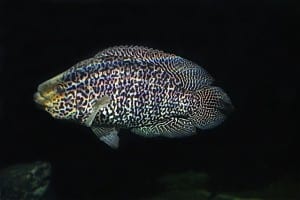
Common Name: Jaguar Cichlid
Scientific Name: Parachromis Managuense, Parapetenia Managuense
Average Adult Fish Size: 1.3 feet / 40 cm !!
Place of Origin: The Jaguar cichlid is native to Central America where it can be found in lakes, ponds and springs in Nicaragua, Honduras and Nicaragua. Today, the Jaguar cichlid has been introduced by man to a majority of the other Central American countries and established populations are known from El Salvador, Guatemala and Panama.
Typical Tank Setup: Mainly open with some rocky territories. Aquariums that house pairs must give adequate hiding places for a harassed female.
Recommended Minimum Aquarium Capacity: 125 gallon / 500 litre for one, 180 gallon / 720 litre for a pair
Compatibility: Jaguars can grow to be a very large and formidable fish. They are not often successfully challenged in an aquarium environment. Best kept with similar sized subordinate cichlid species in large aquariums.
Temperature: 77 – 97 Deg F / 25 – 36 Deg C
Water Chemistry: pH 7.0 – 8.7
Feeding: In the wild, the Jaguar cichlid is a skilled predator that feeds chiefly on fish and big invertebrates. Soft rayed fish is preferred, but the Jaguar cichlid is not fuzzy about its food. It will appreciate live food in the aquarium, but training it onto pellets is not difficult. Choose a high quality pellet that has been made to meet the nutritional needs of larger predator fish. If you do not produce your own live food, you should keep in mind that feeder fish from pet stores might introduce disease in the aquarium. Many Jaguar cichlid keepers therefore feed their Jaguar cichlids fish meat instead. Earthworms and krill are two other good choices.
Sexing: Until the Jaguar cichlids are mature, they are very hard to sex since they display the same dark stripes. As the male matures, he will however loose his dark stripes, a detail that makes sexing much easier. The male Jaguar cichlid will also typically grow bigger than the female, and display dark speckles on his body against a golden background. Venting is the only sure way to determine gender with smaller Jaguars.
Breeding: If you want to breed Jaguar cichlids, you must provide the couple with their own aquarium. The couple will become extremely vicious during the breeding period, and they might even attack your hand if you come too close to their offspring. The Jaguar cichlid will usually become sexually mature when it has reached a size of 4 inches/10 centimeters.
The Jaguar cichlid couple is not only aggressive toward other fish; they can also be aggressive towards each other. You should therefore arrange a breeding aquarium where it is possible for the smaller female to escape the attacks of the larger male Jaguar cichlid. You can for instance divide the aquarium using a net with a hole that is too small for the male to swim through.
The method of reproduction for Jaguar cichlids is similar to that of many other cichlid species. During the spawning, the female Jaguar cichlid will deposit her eggs on a flat surface like a piece of slate. A female Jaguar cichlid can produce up to 500 eggs during each spawning. The male will fertilize the eggs and stay around to protect them from predators. The female will provide the eggs with fresh, oxygenated water by fanning the breeding site. After approximately 3-5 days the eggs will hatch. The larvae do not need any food during the initial 5-8 days since they will receive nutrition from their yolk sacs. When the yolk sac has been devoured, the adult Jaguar cichlids will start feeding their young one organic matter. Using a new aquarium with very little organic matter as a breeding aquarium for Jaguar cichlids is therefore not recommended; a well established aquarium is much better. As the fry grow larger, you can star giving them newly hatched brine shrimp and/or powdered flake food. Micro worms are also appreciated. If the Jaguar cichlid batch is large, you must cull it regularly.
Additional Information: Jags are a very large and aggressive cichlid. Watch your fingers when cleaning the aquarium!


Related Posts
Croaking Gourami – Trichopsis vittatus
Benthochromis Tricoti
Large-eyed Mouthbrooder – Callochromis Macrops